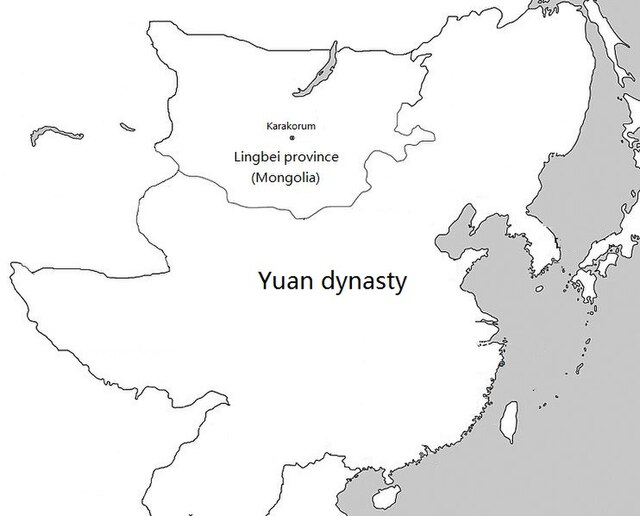The Yuan dynasty ruled over the Mongolian Plateau, including both Inner and Outer Mongolia as well as part of southern Siberia, between 1271 and 1368. The Mongolian Plateau is where the ruling Mongol Borjigin clan of the Yuan dynasty came from, thus it enjoyed a somewhat special status during the Yuan dynasty, although the capital of the dynasty had been moved from Karakorum to Khanbaliq since the beginning of Kublai Khan's reign, and Mongolia had been converted into a regular province, known as the Lingbei Province, by the early 14th century.
Mongolia within the Yuan dynasty under the Lingbei province
Kublai Khan, also known by his temple name as the Emperor Shizu of Yuan and his regnal name Setsen Khan, was the founder and first emperor of the Mongol-led Yuan dynasty of China. He proclaimed the dynastic name "Great Yuan" in 1271, and ruled Yuan China until his death in 1294.
Portrait by artist Araniko, drawn shortly after Kublai's death in 1294. His white robes reflect his desired symbolic role as a religious Mongol shaman.
Portrait of young Kublai by Araniko, a Nepali artist in Kublai's court
Kublai Khan was chosen by his many supporters to become the next Great Khan at the Grand Kurultai in the year 1260. Kublai Khan and His Empress Enthroned, from a Jami al-Twarikh (or Chingiznama). Mughal dynasty, Reign of Akbar, 1596. Mughal Court. Opaque watercolor, ink, and gold on paper. India. Freer Gallery of Art. F1954.31 [1]
Kublai Khan in the Catalan Atlas (1375). The caption reads: "The most powerful prince of the Tartars is named Holubeim [Kubilay Khan], that means Great Khan. This emperor is richer than any other emperor in the world. This emperor is protected by twelve thousand horsemen with their four captains that stay at the court three months of the year."





![Kublai Khan in the Catalan Atlas (1375). The caption reads: "The most powerful prince of the Tartars is named Holubeim [Kubilay Khan], that means Grea](https://upload.wikimedia.org/wikipedia/commons/thumb/e/e9/Kublai_Khan_in_the_Catalan_Atlas_%281375%29.jpg/372px-Kublai_Khan_in_the_Catalan_Atlas_%281375%29.jpg)